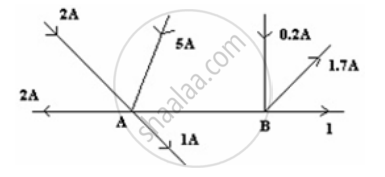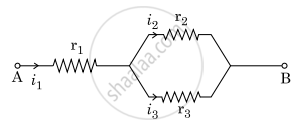Advertisements
Advertisements
प्रश्न
State Kirchhoff's rules and explain on what basis they are justified.
उत्तर
Kirchhoff’s first rule (Junction rule): The algebraic sum of the currents meeting at a point in an electrical circuit is always zero.
\[\sum_{} I = 0\]
This law is justified on the basis of law of conservation of charge.
Kirchhoff’s second law (Loop rule): In a closed loop, the algebraic sum of the emfs is equal to the algebraic sum of the products of the resistances and the current flowing through them.
\[\sum_{} I = 0\]
This law is justified on the basis of law of conservation of energy.
APPEARS IN
संबंधित प्रश्न
Kirchhoff's junction law is equivalent to .............................
(a) conservation of energy.
(b) conservation of charge
(c) conservation of electric potential
(d) conservation of electric flux
A potentiometer wire has a length of 4 m and resistance of 20 Ω. It is connected in series with resistance of 2980 Ω and a cell of emf 4 V. Calculate the potential along the wire.
The instrument for the accurate measurement of the e.m.f of a cell is ______.
Kirchhoff’s second law is a consequence of law of conservation of ______.
Figure shows current in a part of an electrical circuit. Then current I is ______.

Two cell of 1.25 V and 0.75 V are connected parallel. The effective voltage will be:-
Three resistors having resistances r1, r2 and r3 are connected as shown in the given circuit. The ratio `"i"_3/"i"_1` of currents in terms of resistances used in the circuit is :

Power P is to be delivered to a device via transmission cables having resistance RC. If V is the voltage across R and I the current through it, find the power wasted and how can it be reduced.
A 6-volt battery is connected to the terminals of a three-metre-long wire of uniform thickness and resistance of 100 ohms. The difference of potential between two points on the wire separated by a distance of 50 cm will be ______.
The figure below shows two batteries, E1 and E2, having emfs of 18V and 10V and internal resistances of 1 Ω and 2 Ω, respectively. W1, W2 and W3 are uniform metallic wires AC, FD and BE having resistances of 8 Ω, 6 Ω and 10 Ω respectively. B and E are midpoints of the wires W1 and W2. Using Kirchhoff's laws of electrical circuits, calculate the current flowing in the wire W3:

